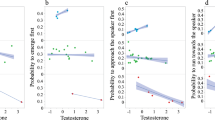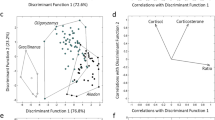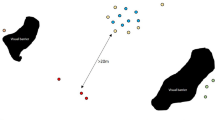Abstract
In this research we examined hormonal correlates of hand preference in free-ranging primates. Specifically, we tested the hypothesis that levels of the stress hormone cortisol and the male sex hormone testosterone are correlated with handedness in male rhesus macaques (Macaca mulatta). We found significant positive relationships between cortisol and testosterone levels sampled during adolescence and the frequency of right- versus left-hand use sampled during adulthood. These data indicate that adolescent measures of cortisol and testosterone are correlated with hemispheric specialization in adult free-ranging primates.
Similar content being viewed by others
Log in or create a free account to read this content
Gain free access to this article, as well as selected content from this journal and more on nature.com
or
References
Bradshaw J, Rogers L . (1993): The Evolution of Lateral Asymmetries, Language, Tool-Use, and Intellect. New York, Academic Press
Ciochon RL, Fleagle JG . (1985): Primate Evolution and Human Origins. Menlo Park, CA, Benjamin/Cummings Publishing Company, Inc.
Drea CM, Wallen K, Akinbami MA, Mann DR . (1995): Neonatal testosterone and handedness in yearling rhesus monkeys (Macaca mulatta). Physiol Behav 58: 1257–1262
Fagot J, Drea CM, Wallen K . (1991): Asymmetrical hand use in rhesus monkeys (Macaca mulatta) in tactually and visually regulated tasks. J Comp Psychol 105: 260–268
Fleagle JG . (1986): Primate Adaptations and Evolution. Orlando, FL, Academic Press, Inc.
Geschwind N, Galaburda AM . (1985a): Cerebral lateralization: biological mechanisms, associations, and pathology: II. A hypothesis and a program for research. Arch Neurol 42: 521–552
Geschwind N, Galaburda AM . (1985b): Cerebral lateralization: biological mechanisms, associations, and pathology: III. A hypothesis and a program for research. Arch Neurol 42: 634–654
Harris LJ, Carlson DF . (1993): Hand preferences for visually-guided reaching in human infants and adults. In Ward JP, Hopkins WD (eds), Primate Laterality: Current Behavioral Evidence of Primate Asymmetries. New York, Springer-Verlag, pp 285–306
Henry JP . (1993): Psychological and physiological responses to stress: the right hemisphere and the hypothalamo-pituitary-adrenal axis, an inquiry into problems of human bonding. Integrative Physiolog Behav Sci 28: 369–387
Kalin NH, Larson C, Shelton SE, Davidson RJ . (1998): Asymmetric frontal brain activity, cortisol, and behavior associated with fearful temperament in rhesus monkeys. Behav Neurosci 112: 286–292
Lindesay J . (1987): Laterality shift in homosexual men. Neuropsychologia 25: 965–969
MacNeilage PF, Studdert-Kennedy MG, Lindblom B . (1987): Primate handedness reconsidered. Behav Brain Sci 10: 247–303
McCormick CM, Witelson SF, Kingstone E . (1990): Left-handedness in homosexual men and women: neuroendocrine implications. Psychoneuroendocrinology 15: 69–76
Moffat SD, Hampson E . (1996): Salivary testosterone levels in left- and right-handed adults. Neuropsychologia 34: 225–233
Schneider ML, Suomi SJ . (1992): Neurobehavioral assessment in rhesus monkey neonates (Macaca mulatta): developmental changes, behavioral stability, and early experience. Infant Behav Dev 15: 155–177
Spivak B, Segal M, Mester R, Weizman A . (1998): Lateral preference in post-traumatic stress disorder. Psychol Med 28: 229–232
Warren JM . (1980): Handedness and laterality in humans and other animals. Physiol Psychol 8: 351–359
Westergaard GC, Champoux M, Suomi SJ . (1997): Hand preference in infant rhesus macaques (Macaca mulatta). Child Dev 68: 387–393
Westergaard GC, Kuhn HE, Suomi SJ . (1998): Bipedal posture and hand preference in humans and other primates. J Comp Psychol 112: 55–64
Westergaard GC, Lussier ID . (1999): Left-handedness and longevity in primates. Int J Neurosci 99: 79–87
Witelson SF . (1991): Neural sexual mosaicism: sexual differentiation of the human temporo-parietal region for functional asymmetry. Psychoneuroendocrinology 16: 131–153
Wittling W, Pfluger M . (1990): Neuroendocrine hemisphere asymmetries: salivary cortisol secretion during lateralized viewing of emotion-related and neutral films. Brain Cognit 14: 243–265
Acknowledgements
The subjects for this research are part of a breeding colony supported by LABS of Virginia Inc. under Food and Drug Administration Contract 223-92-1101. LABS of Virginia Inc. is an AAALAC accredited institution. The LABS of Virginia Inc. Animal Care and Use Committee approved a research protocol for this study in accordance with and as required by the Animal Welfare Act. The authors thank Dr. Phillip Snoy (FDA) and LABS of Virginia Inc. for authorization to conduct this research.
Author information
Authors and Affiliations
Corresponding author
Rights and permissions
About this article
Cite this article
Westergaard, G., Chavanne, T., Lussier, I. et al. Hormonal Correlates of Hand Preference in Free-ranging Primates. Neuropsychopharmacol 23, 502–507 (2000). https://doi.org/10.1016/S0893-133X(00)00141-X
Received:
Revised:
Accepted:
Issue date:
DOI: https://doi.org/10.1016/S0893-133X(00)00141-X



